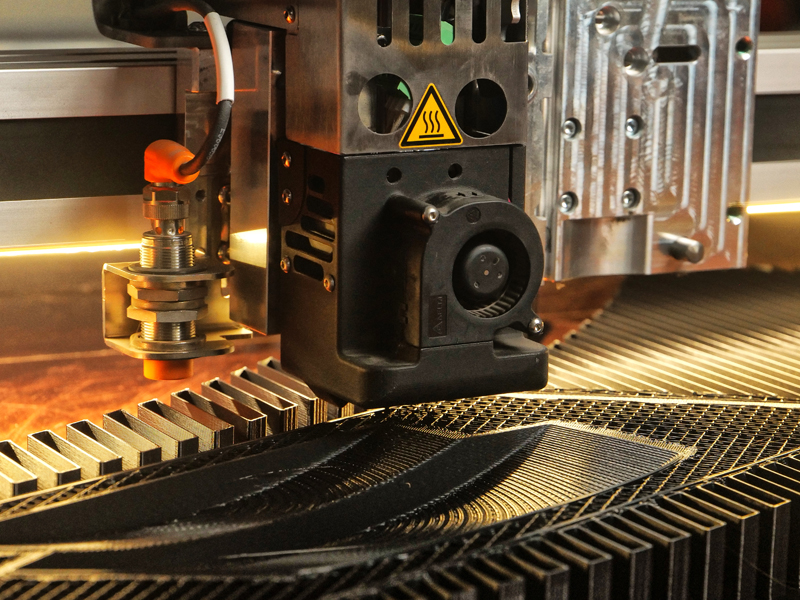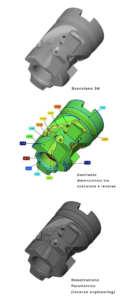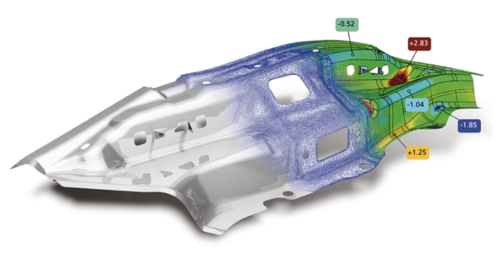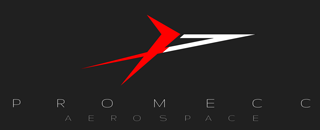Reverse Engineering
Reverse engineering. We create a new tool with the same characteristics as the original one, but with greater efficiency.

Promecc 3D offers a reverse engineering service. It concerns a detailed analysis of the functioning, design and development of an object with the main purpose of creating a new one that preserves the same characteristics as the original one, with the sole difference of a greater efficiency.
In the field of design, the term Reverse Engineering summarizes the whole 3D digitization process of a physical object to perform an analysis or to carry out a computerized remodeling using specific software.
In order to obtain files usable with the most common CAD software (Solidworks, Catia, Cimatron, PowerShape, etc.), it is necessary to convert the STL files (point cloud) obtained through the 3D scanning into a file composed by well-defined geometric entities: it is precisely this process that is defined as reverse engineering.
In particular, it can be carried out using several techniques and software, depending on the specific final needs.
The most commonly used types of reverse engineering are:
- Parametric 3D construction – the final file consists of fillets, planes, curves and cylinders that are recognizable by various CAD software.
- 3D reconstruction for exact surfaces – the file is composed by a series of surfaces that are “laid” over the scan like a “skin”. This system is especially recommended when the shapes are described as “organic”.
Reverse engineering, parametric 3D reconstruction, the phases of the Reverse Engineering process.
The reverse engineering process mainly consists of two phases:
ACQUISITION
 The object is digitized by 3D scanning (both optical and contact-based), to obtain a set of continuous points commonly called “point cloud”.
The object is digitized by 3D scanning (both optical and contact-based), to obtain a set of continuous points commonly called “point cloud”.
In order to be visualized in dedicated software, this is represented by a series of polygons connecting all the acquired points among them and this is called a “polygonal mesh”. The higher the density of the acquired points, the better the approximation of the “mesh” will be.
TRASNFORMATION
 The point cloud of parametric entities is reprocessed by geometrically and rationally approximating the “mesh” of departure. The new software dedicated to reverse engineering – like, for example, Geomagic Design X – allow solid remodeling directly from data extrapolated from the “mesh”. During this phase, the possible presence of “background noise”, discontinuity areas and scan distortions, can compromise the precision of approximation. For this reason, before proceeding with transformation, it is important to reduce these imperfections with the appropriate tools.
The point cloud of parametric entities is reprocessed by geometrically and rationally approximating the “mesh” of departure. The new software dedicated to reverse engineering – like, for example, Geomagic Design X – allow solid remodeling directly from data extrapolated from the “mesh”. During this phase, the possible presence of “background noise”, discontinuity areas and scan distortions, can compromise the precision of approximation. For this reason, before proceeding with transformation, it is important to reduce these imperfections with the appropriate tools.
Areas of application of reverse engineering
3D reconstruction and modeling through reverse engineering have an almost unlimited field of application; in particular, they can be used in the sculptural, industrial, mechanical, aerospace, aeronautical, automotive, civil, architectural and medical sectors.
MECHANICS
Applications in mechanics are the most known but also the most complex ones, due to the industrial sectors in which it plays a key role. In this field, continuously evolving CAD/CAM software is used, which allows increasingly better results and simultaneously requires tools capable of verifying them in the best possible way. In this sense, it is precisely the optical scanning that makes the difference. The possibility to take much more precise measurements allows pushing the quality of the works always higher. The possibility of recovering some projects on the fly without the necessity to start from scratch is an enormous advantage in terms of time and costs, and therefore is fundamental in the current industrial landscape. Promecc 3D offers a valid support to the mechanical companies that want to increase their quality level, providing a customized reverse engineering service. For example, for companies that produce molds, Promecc 3D offers the possibility to recover a parametric 3D file from old models or models not designed with CAD (made with copy mills), from which they can obtain a more modern and digital product. Making in-depth and quality dimensional checks creating a customized and detailed report for every need can also be a distinctive feature of the offered products and of their way of working.
ART AND RESTAURATION
Optical scanning – already known in this field – allows preservation and restoration of all the objects that are difficult to return to their original state. Reverse engineering and 3D reconstruction, for example, are particularly useful in the recovering phases, when it’s not possible to restore the object due to the poor conditions of some of its parts: in this case, through a 3D scanner for reverse engineering, it is possible to acquire the portion in question and then reconstruct it first in 3D and later physically using the chosen technologies without altering the original charm and design. Another application of this technology in the artistic sector can be the use of the scan for digital reproductions in virtual museum. In this case, the STL file can be covered with the original textures, obtained from the scan of it or from other photographic procedures placed in the designated area.
MODELING
Just a few years ago, modeling was a very limited sector: the high costs and the limited availability of materials and equipment had relegated it to a niche activity. Nowadays, with the arrival of new, quite affordable technologies, the situation has significantly improved. The access to 3D CAD programs, like Sketchup, Rhino or the opensource Blender, has allowed many enthusiasts to develop ideas and even very complex customized projects. Promecc 3D offers to companies and enthusiasts of the sector the best solutions for modifying some static modeling details, permitting an efficient correction of flaws and imperfections of the models. By analyzing and comparing 3D and the model in question, Promecc 3D is able to deliver a file ready to be printed by the latest 3D printers.
INDUSTRIAL DESIGN
Industrial design includes countless sectors, among which are car design, furniture design, yacht design, lighting design. In this field, the optical scanning is a valuable support for the designer who, after having created the sketches or prototypes of his idea, needs to bring them to life. Promecc 3D scans the model and delivers a printable file to the client, ready for 3D printing, editable and permanent. Any further modification to this file can be made on a Pc with a CAD program or on the original model, having an excellent basis for the following phases of development and production.
